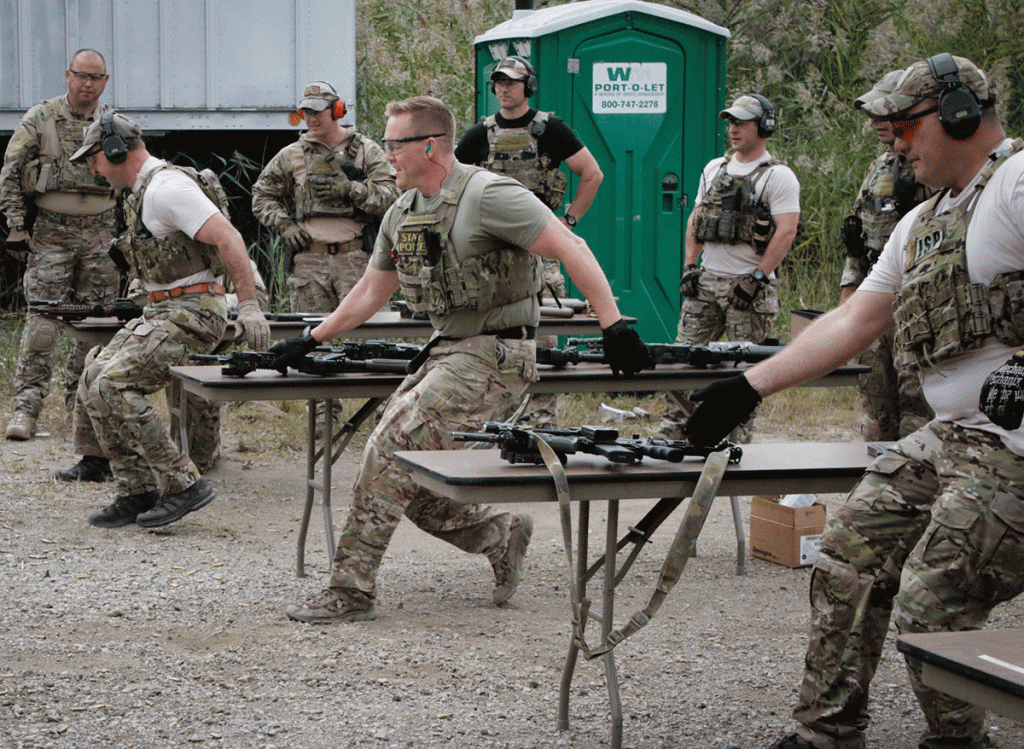By Rob Shaul
In our visits to special forces teams to teach programming courses, we often work with teams that don’t do their fitness training together. Some teams and SOF guys consider required training a step back to line unit requirements and restrictions.
“We have big boy rules,” I’m told. Guys are allowed to train on their own and expected to be mission capable at all times. It’s on them.
Our programming courses often include two training sessions – one strength and one work capacity – , where we put students through the session to demonstrate first-hand session design and theory in action.
When we teach units who don’t train together, we generally see three groups of athletes during these training sessions:
- Strong guys who need cardio
- Cardio guys who are weak
- All around guys (strength and cardio) who are generally the ones that brought us in and had been doing our Operator Sessions.
When guys don’t have fitness programming direction, a couple of things generally happen.
– They do what they’re good at. So the Group 1 guys are good at strength and avoid work capacity and endurance. The Group 2 guys are good at work capacity and endurance and thus avoid strength training.
– They do what they’ve always done. Generally, this aligns with what they’re good at.
It takes an ego-free individual to admit fitness weaknesses, and focus on improving them.
Next comes the understanding that fitness training must be determined by the job’s physical demands, break that down, and train accordingly. Many don’t have the knowledge or time and dip into their own pockets to follow our stuff.
Occasionally we’ll work with SOF leaders who discard the “big boy rules” for training and make their teams consistently train together. These teams seem the most cohesive and their fitness the most well rounded.
But this issue isn’t limited to SOF. Line Units have a similar issue – fitness programming responsibility isn’t pushed to the individual, but often it’s pushed down to the Company Commander who pushes it down to the Platoon Commander who pushes it down to the Squad Leaders.
Squad leaders do the fitness programming for their squads, and usually what happens is each Squad ends up doing what the Squad Leader is good at or has always done (see the pattern?)
It’s hard to find a company commander or above who hasn’t made fitness one of his command priorities, yet, just about everyone ends up doing their own thing.
I recently had an email back and forth with an incoming battalion commander who was interested in our Grunt PT for his unit, but was hesitant to order Grunt PT so his guys could “own the programming.”
I asked him if his soldiers were likewise allowed to “own” the programming/practice for their fire and maneuver drills, and battlefield communications. The answer was no. Everyone obviously needs to be on the same page.
“PT is just as important to mission performance as this stuff, “I countered. “Wouldn’t it benefit you to know as a CO what your guys are physically capable of? Is this not mission-direct information?”
“If everyone is doing their own PT programming,” I wrote, ” you don’t know.”
Marksmanship
I believe big boy rules also don’t work for marksmanship, based on my work with units teaching Range Fitness courses. Few athletes smoke our drills when they first experience them. Which is understandable.
Where I see the differences in units and individuals is how they initially react to not doing especially well.
Some guys blame their weapon, the drill, size of the target, or me.
Others don’t take it personally, seeing it as a learning opportunity, and calmly fall back to focus on their marksmanship fundamentals.
During the course, both groups improve drill performance. The first group improves through repetition. Just doing the drills leads to steady, but limited improvement. This group focuses on drill performance.
The second group’s improvement rises slower…. at first. These guys, rather than focussing on drill performance, focus on marksmanship fundamentals – trigger control, especially – and applying the fundamentals to whatever shooting task is presented. Once they figure this out, it’s game on, and by the end of the course, several are near the top of possible drill performance.
When I speak to the teams about their regular range training, what I find is it mirrors what often happens in the gym: Guys do what they’re good at, or what they’ve always done.
With both areas, fitness, and marksmanship – the challenge for super busy soldiers is the programming. I’ve been to several SOF units that have on-staff strength and conditioning coaches and incredible facilities, but still, they need programming direction.
It seems often the on staff coaches are made available to guys, but guys aren’t required to use them (big boy rules). Also, many of the coaches come from team-sport training backgrounds and try, unsuccessfully, to apply what works for baseball players to military athletes. There’s a disconnect which leads to frustration on both sides.
Centralized programming for fitness and marksmanship training allows assessment, which allows the analysis that identifies weaknesses. Identified programming weaknesses drive programming change for the next go around and the loop starts again: programming, assessment, analysis, improved programming, assessment, analysis, improved programming, etc.
All of this results in continuous improvement, which leads to better mission performance.
Questions, Comments, Feedback? Email coach@mtntactical.com
